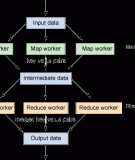
http://www.iaeme.com/IJMET/index.asp 864 editor@iaeme.com
International Journal of Mechanical Engineering and Technology (IJMET)
Volume 10, Issue 03, March 2019, pp. 864-875. Article ID: IJMET_10_03_089
Available online at http://www.iaeme.com/ijmet/issues.asp?JType=IJMET&VType=10&IType=3
ISSN Print: 0976-6340 and ISSN Online: 0976-6359
© IAEME Publication Scopus Indexed
THE CRITICAL SUCCESS FACTORS FOR BIG
DATA ADOPTION IN GOVERNMENT
Novan Zulkarnain
Computer Science Department, BINUS Graduate Program, Doctor of Computer Science
Information System Department, School of Information System
Bina Nusantara University, Jakarta, Indonesia 11480
Meyliana*
Information System Department, School of Information System
Bina Nusantara University, Jakarta, Indonesia 11480
Ahmad Nizar Hidayanto
Faculty of Computer Science
Universitas Indonesia, Depok, Indonesia 16424
Harjanto Prabowo
Management Department, BINUS Business School Undergraduate Program
Information System Department, School of Information System
Bina Nusantara University, Jakarta, Indonesia 11480
ABSTRACT
Over the past decade, governments around the world have been trying to take
advantage of Big Data technology to improve public services with citizens. The
adoption of Big Data has increased in most countries, but at the same time, the rate of
successful adoption and management varies from one country to another. A systematic
review of the literature (SLR) was carried out to identify the critical success factors
(CSF) for the adoption of big data in the government. It includes the critical success
factor of the adoption of Big Data in the government in the last 10 years. It presents
the general trends that examine 183 journals and numerous literary works related to
government operations, the provision of public services, citizen participation, decision
making and policies, and governance reform. We selected 90 journals and found 11
classification factors that refer to the successions of a Big Data adoption in the
government.
Keywords: Critical success factors; CSFs; Big Data; E-Government; systematic
literature review; SLR.

The Critical Success Factors for Big Data Adoption in Government
http://www.iaeme.com/IJMET/index.asp 865 editor@iaeme.com
Cite this Article Novan Zulkarnain, Meyliana, Ahmad Nizar Hidayanto, Harjanto
Prabowo The Critical Success Factors for Big Data Adoption in Government,
International Journal of Mechanical Engineering and Technology, 10(3), 2019, pp.
864-875.
http://www.iaeme.com/IJMET/issues.asp?JType=IJMET&VType=10&IType=3
1. INTRODUCTION
Amazingly, every day the world produces about 2.5 million bytes of data or 1 billion
gigabytes [1]. These data include textual content (i.e. structured, semi-structured and
unstructured), multimedia content (e.g. video, images, audio) on a variety of platforms (e.g.,
machine-to-machine communication, social networking sites, networks) of sensors, cybernetic
systems and the Internet of Things [IoT]) [2]. A large amount of data may also come from
other relevant areas, such as banks, education, military, medical research, public health, smart
cities, security management, emergencies and disaster recovery [3]. The increase in data
causes a problem about how to store and manage such heterogeneous datasets with moderate
requirements in the hardware and software infrastructure [4]. Industry, education, and
governments around the world are very aware and understand the importance of large
amounts of data, commonly known as Big Data or Open Data [4]. Commonly, the industry
uses big data for analysts of customer opinions, behavioral analysis, customer satisfaction,
predictive support and fraud detection [5]. In the field of education, Big Data is used to
analyze and extract useful trends, educational models, personalize learning, standardize the
presentation of knowledge and use it to provide better education and also curriculum [6]. And
the government uses Big Data to improve information and government service for its citizens
[7], quickly addressing basic needs, providing quality education and reducing the
unemployment rate [8]. It will create better health, better teachers, better education and better
decision-making processes [9].
Large amounts of money are needed to build and implement large amounts of data. The
government of the United States, in early 2006, the state legislator allocated $ 9.5 million to
boost Big Data for the public sector [10]. In March 2012, the Obama administration
announced a $ 200 million investment to launch the Big Data research and development plan
in several government agencies [4]. In 2013, the Korean government decided to invest $ 500
million in the Big Data on Government 3.0 project over the next 5 years [11]. In addition, the
lesson of the Chinese government has 731 million Internet users according to government
statistics in January 2017. In addition, 695 million users use the Internet through mobile
devices. And it has invested $ 14.4 billion to share data on the Internet of Thing (IoT) [12].
On this basis, it is clear that one of the critical success factors is the government budget. Many
in developing countries have the same problem, the problem of costs and management. For
funds to be used efficiently, funds must be properly managed. Good project management is
the key to the adoption of big data in government. A top-down approach to managing and
integrating big data is also needed [13].
Before Government Adopting Big data, they have to mature their infrastructure for
supporting. One recommendation choice for adopting Big Data is using Cloud Computing
Infrastructure. Its benefits include cost efficiency, unlimited storage, backup and recovery,
automatic software integration, easy access to information, rapid deployment, a simpler scale
of services and provision of new services [14]. Some paper also said parallel computing is one
of the fundamental infrastructures for the management of big data activities. It is capable of
performing simultaneously the activity of the algorithm in a group of machines or
supercomputers [15].

Novan Zulkarnain, Meyliana, Ahmad Nizar Hidayanto, Harjanto Prabowo
http://www.iaeme.com/IJMET/index.asp 866 editor@iaeme.com
To build a sustainable Big Data infrastructure, data integration is the key [16].
Governments should try to rebuild large data control towers to integrate cumulative,
structured or unstructured sets of departmental silos [13]. The basic requirements of the
infrastructure level should be considered according to the types of government organizations,
data use, and energy consumption with environmental impact. It is preferable to use your own
data centers with a private cloud structure as a basic security measure. [17].
Furthermore, some types of research are underway in the adoption of big data in the
government. They implemented it successfully. Some research claims that the adoption of
large amounts of data in governments meant the same thing as the adoption of data in industry
or academia [18]. Therefore, we use a review of the literature that has a relationship between
Big Data and Industry or Business, Big Data and Education, and the last major focus on Big
Data and Government. Therefore, this research tries to define a question: "What are the
critical success factors of the adoption of big data in the government?"
2. METHODOLOGY
This research conducted a comprehensive review of the study literature on the investigation of
the adoption of large data on government. This process is divided into several parts, which
are: determine the sources of research, define the keyword model for a research process,
initiate the inclusion and exclusion criteria, extract data and analyze the result to answer a
research question.
2.1. Search Process
The first process is to define the source of literature to find an adequate article/journal. The
sources selected for the systematic review of the literature are the following:
ACM Digital Library (dl.acm.org)
Elsevier (www.sciencedirect.com)
IEEE Xplore Digital Library (ieeexplore.ieee.org)
Igi Global (www.igi-global.com)
Sage (www.sage.com)
Springer (link.springer.com)
Taylor & Francis (taylorandfrancisgroup.com/journals/)
Wiley Online Library (onlinelibrary.wiley.com)
To find the desired paper. We use several keywords and a combination of Boolean
operators. The Boolean operators that we use in this paper, such as OR, and AND. The
combination of keywords is as follows:
((critical OR success OR factor) OR CSF) AND ((big AND data AND adoption) OR BD)
AND (((electronic AND government) OR e-gov) OR ((public AND sector) OR nonprofit))
((key OR success OR factor) OR CSF) AND ((big AND data AND project) OR BD) AND
(((electronic AND government) OR e-gov) OR ((public AND sector) OR nonprofit))
(Success OR Adoption) AND (Big AND Data) AND (Government Or E-Government Or E-
Gov)
(Big AND Data) And (Adoption OR Success) And (Government Or E-Government Or E-
Gov)

The Critical Success Factors for Big Data Adoption in Government
http://www.iaeme.com/IJMET/index.asp 867 editor@iaeme.com
In the meantime, to clarify the validity of the literature, the criteria for exclusion of
research are defined in some procedures, which are:
The document based on its publication date between 2008 and 2018.
The structure of the complete document, which means that any identity
(newspaper/conference, the identity of the author, etc.) is mentioned in the document.
Duplicate card from the same study in SLR is excluded.
2.2. Data Extractions
The studied literature has been examined 572 documents as resources and criteria. Out of 572
articles examined, there are 183 articles that were to be candidate studies on the related and
abstract title to the research question. After studying further, we look for a case that is
relevant to the success of big data adoption in the government, and there are only 86
documents that could be used in this research.
Table 1. Publisher and Number of Selected Papers
Source
Found
Relevant
Selected
ACM
242
29
15
Elsevier
149
62
27
IEEEXplorer
107
58
28
IG Global
8
2
2
SAGE
5
5
1
Springer
23
9
4
Taylor & Francis
21
11
6
Wiley
16
7
3
Total
572
183
86
3. RESULT AND DISCUSSION
This research aimed to investigate the critical success factor of the adoption of big data for a
government. The use of social networks in a higher institution has emerged as a new
opportunity and a challenge both for basic functional use and for specific academic use. On
this basis, this study will identify the general component of e-learning to define the
collaboration of social networks and e-learning [5].
Most authors expertise in" Big Data" was come from the USA, China, Netherland, United
Kingdom, Indonesia, Canada, and India. For most Paper related to the topic’s was from the
USA, China, United Kingdom, Netherland, India, and Canada. and Australia. Surprisingly,
there no paper from Denmark, Germany, Iraq, Kuwait, Oman, Papua New Guinea, Portugal
and Slovenia, even the author affiliate is coming from that country.
Table 2. Number and Country of the Authors
Country of the Author
Paper
%
Author
%
Australia
6
3
3
3
Austria
6
3
2
2
Brunei
3
2
2
2
Canada
11
6
4
5
China
23
12
12
14
Czech Republic
2
1
1
1
Denmark
1
1
0
0
Finland
4
2
1
1
France
4
2
2
2
Germany
1
1
0
0

Novan Zulkarnain, Meyliana, Ahmad Nizar Hidayanto, Harjanto Prabowo
http://www.iaeme.com/IJMET/index.asp 868 editor@iaeme.com
India
10
5
5
6
Indonesia
11
6
2
2
Iraq
1
1
0
0
Italy
3
2
2
2
Japan
1
1
1
1
Kuwait
1
1
0
0
Macao
2
1
1
1
Malaysia
9
5
3
3
Marocco
5
3
2
2
Netherland
16
8
6
7
Oman
1
1
0
0
Papua New Guinea
1
1
0
0
Portugal
1
1
0
0
Republic of Korea
2
1
1
1
Slovenia
1
1
0
0
South Africa
4
2
2
2
South Korea
5
3
2
2
Sweden
1
1
1
1
Switzerland
1
1
1
1
UAE
1
1
1
1
United Kingdom
15
8
6
7
USA
43
22
23
27
Total
196
100
86
100
Table 3. Critical Success Factor’s
Critical Success
Factor
Source
Cost Effective /
Efficient
[2], [4], [28], [27], [25], [36], [37], [38]
[39], [20]
Management
Supporting
[28], [40], [25], [13], [41], [39], [20]
Infrastructure
[6], [42], [43], [25], [27], [44]
Communication
[24], [45], [13], [25], [27], [44]
Skilled Team / Staff
[28], [27], [25], [46], [47], [48], [49], [20]
[50]
Political Stability
[51], [32], [12], [10], [52], [53], [54], [55]
Social & Culture
[45], [56], [55], [57], [32], [58], [39], [4],[59], [35],
[60], [61], [62], [63]
Citizen Involvement
[46], [11], [32], [54], [12], [53], [62], [64]
[4], [65], [61], [21], [66], [67]
Organization Maturity
[21], [24], [53], [35], [4], [50], [48], [61]
Privacy & Security
[12], [54], [68], [39], [2], [69], [70], [38], [57], [64],
[13]
Realistic Plan /
Objective
[12], [28], [39], [51], [4], [36], [21], [5]
[64], [71], [54]
Table 3 shows the critical success factor that has been found in 86 selected literature. We
found 11 CSF, that has a major issue which relevant on the topics.
3.1. Cost Effective / Efficient
Cost is high for adopting Big Data System [19]. This will be a major problem and a challenge
for developing country. Cost is mostly used for infrastructure, technology, and consultant for
helping the government to integrate the big data system [12].









![Đề thi giữa kì 1 môn Cấu trúc dữ liệu và giải thuật: Tổng hợp [Năm]](https://cdn.tailieu.vn/images/document/thumbnail/2012/20121223/loc_x_m/135x160/621356314200.jpg)
















